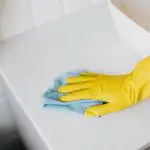Are you tired of looking at plain plastic surfaces in your home or office? Gluing fabric onto plastic is an easy and creative way to add some personality to your space. Whether you want to cover a plastic storage container or add a fun design to a plastic chair, this DIY project is simple and affordable.
Before you get started, it’s important to choose the right glue for the job. Not all adhesives will work well with fabric and plastic, so taking the time to research and select the right one will save you time and frustration in the long run.
With the right materials and a little patience, you’ll be able to transform your plain plastic items into unique pieces that reflect your personal style.
Table of Contents
Understand the Importance of Choosing the Right Glue
You gotta make sure you choose the right glue if you want that fabric to stick to that plastic! The wrong glue can cause the fabric to peel off, ruining your project.
When choosing glue, consider the type of fabric and plastic you’re working with. Some glues work better with certain materials than others.
For example, if you’re working with a plastic that is non-porous, such as a PVC pipe, you’ll need a strong adhesive like cyanoacrylate. However, if you’re working with a porous plastic, such as a plastic bucket, a glue like E6000 would be a better choice.
It’s important to do your research and choose a glue that is compatible with the materials you’re working with.
Another factor to consider when choosing glue is the strength of the bond you need. If you’re working on a project that requires a strong bond, such as a piece of furniture, a two-part epoxy would be a good choice. However, if you’re working on a project that doesn’t require as much strength, a fabric glue would work just fine.
Choosing the right glue can make all the difference in the success of your project!
Prepare the Surfaces
Before getting started, it’s crucial to ensure that both surfaces are clean and free of any debris or residue. This will allow the glue to adhere properly and create a strong bond between the fabric and plastic.
Begin by wiping down both surfaces with a clean, damp cloth or sponge. If there are any stubborn stains or residue, use a mild soap or detergent and water to clean the surfaces.
After cleaning the surfaces, allow them to dry completely before applying any glue. This is important because any moisture on the surfaces can affect the glue’s ability to bond. You can use a clean towel or leave the surfaces to air dry.
Once they’re completely dry, you can proceed to the next step. Before applying the glue, it’s recommended to roughen up the surface of the plastic slightly. This’ll help the glue to adhere better and create a stronger bond. You can use sandpaper or a rough sponge to gently roughen up the surface, but be careful not to scratch it too much, as this can affect its appearance.
With these steps, you’re now ready to move onto the next step of gluing the fabric to the plastic surface.
Apply the Glue
When applying the glue to attach fabric to plastic, remember to use a small amount of glue. Too much glue can cause the fabric to warp or create bumps. Apply the glue evenly to create a smooth surface.
Also, leave a small gap between the fabric and plastic to prevent the glue from seeping through.
Use a Small Amount of Glue
To avoid ruining the fabric or plastic, it’s best to apply only a small amount of glue. Here are some tips to help you use just the right amount:
-
Start with a small amount of glue and add more as needed. It’s easier to add more glue than to remove excess glue.
-
Apply the glue in thin, even lines. This will help prevent the glue from seeping through the fabric or creating lumps.
-
Use a toothpick or small brush to apply the glue. This’ll give you more control over the amount of glue you apply.
-
Work in small sections. Applying glue to a large area at once can be overwhelming and lead to using too much glue.
By following these tips, you can ensure that you use just the right amount of glue to bond your fabric and plastic together without causing any damage. Remember, less is often more when it comes to glue!
Apply the Glue Evenly
Achieving a flawless bond is crucial when working with delicate materials, so it’s important to apply the adhesive evenly. When gluing fabric to plastic, you want to make sure that you spread the glue evenly across the surface of the plastic. This will help to ensure that the fabric adheres properly and doesn’t end up wrinkled or bunched up.
To apply the glue evenly, start by applying a small amount to the plastic in a straight line. Then, use a toothpick or a small brush to spread the glue out evenly across the surface. You want to make sure that the glue covers the entire surface of the plastic, but you don’t want to use too much, as this can cause the fabric to become saturated and difficult to work with.
By taking the time to apply the glue evenly, you’ll be able to achieve a strong and durable bond between the fabric and the plastic. This creates a finished product that’s both professional-looking and long-lasting.
Leave a Small Gap Between the Fabric and Plastic
For a professional-looking finish, you’ll want to leave a small gap between your materials when bonding them together. This gap allows for flexibility and movement, which is essential for items that will be regularly used or worn.
Here are four reasons why leaving a small gap is important:
-
Prevents the fabric from stretching: If the fabric’s pulled too tightly across the plastic, it can stretch and distort the shape of the item.
-
Reduces the risk of glue seeping through: When glue’s applied to the fabric, it can easily seep through the fibers and create a mess on the other side. Leaving a small gap reduces the risk of this happening.
-
Allows for a cleaner edge: When the fabric’s glued directly onto the plastic, it can be challenging to get a clean edge. Leaving a small gap allows for trimming excess fabric and creating a neat edge.
-
Prevents cracking: If the fabric’s glued directly onto the plastic without a gap, it can cause the plastic to crack when it flexes. Leaving a small gap gives the plastic the flexibility it needs to withstand movement.
By leaving a small gap between the fabric and plastic, you’ll ensure a clean and professional-looking finish that will last longer. Remember to measure and mark the gap before applying the glue to ensure an even distance all around.
Press the Fabric onto the Plastic
Now, you’ll want to firmly press the fabric onto the plastic surface, making sure to smooth out any wrinkles or air pockets for a seamless finish that will last. Start by placing the fabric onto the plastic surface, making sure that it is aligned correctly. Then, use a roller or your hands to press down on the fabric, starting from the center and working your way outwards towards the edges. Applying a good amount of pressure will ensure that the fabric adheres well to the plastic.
To help you keep track of your progress, you can use a table to create a checklist of the steps you need to follow. Here’s an example:
| Step | Action |
|---|---|
| 1 | Prepare the surface by cleaning it thoroughly and letting it dry completely. |
| 2 | Apply glue to the plastic surface using a brush or applicator. |
| 3 | Leave a small gap between the fabric and plastic. |
| 4 | Press the fabric onto the plastic surface, smoothing out any wrinkles or air pockets. |
| 5 | Let the glue dry completely before using the fabric. |
By following these steps and using a table to keep track of your progress, you’ll be able to successfully glue fabric to plastic. Remember to take your time and apply enough pressure to ensure that the fabric adheres well to the plastic surface. With a little patience, you can create a seamless finish that will last.
Allow the Glue to Dry
Now that you’ve pressed the fabric onto the plastic, it’s time to let the glue do its job. Allow the glue to dry completely before moving on to the next step. This will ensure that the fabric is securely attached to the plastic and won’t come off easily.
While waiting for the glue to dry, it’s important not to disturb the fabric or plastic. Any movement can cause the fabric to shift and ruin the bond forming between the two materials. You can also use a clamp or heavy object to hold the fabric in place while it dries to prevent any movement.
Once the glue has dried, you can inspect the bond between the fabric and plastic. If there are any areas that didn’t bond properly, you can apply more glue and press the fabric onto the plastic again. Remember to allow the glue to dry completely before using the fabric and plastic item. With proper drying time, your project will be able to withstand wear and tear for a long time.
- Be patient and allow the glue to dry completely before moving on to the next step.
- Avoid disturbing the fabric and plastic while the glue is drying.
- Check the bond between the fabric and plastic and apply more glue if needed.
Trim Excess Fabric
After the bond has formed, it’s time to trim any excess material to give the project a clean and finished look. Use a sharp pair of scissors to cut along the edges of the plastic, ensuring that the fabric is flush with the edges. Take your time and make sure that you don’t cut too much fabric, as this can ruin the look of your project.
If you’re working with a curved or intricate shape, use small, precise cuts to make sure that the fabric fits perfectly. You can also use a craft knife or rotary cutter for more precise cutting. Take your time and be patient, as rushing this step can result in a sloppy finish.
Once you have trimmed the excess fabric, take a step back and admire your work! The fabric should be firmly attached to the plastic, and the edges should be clean and neat.
If you notice any loose threads or fraying fabric, use a pair of small scissors to carefully trim them away. With a little bit of patience and attention to detail, you can easily glue fabric to plastic and create beautiful, customized projects.
Enjoy Your Newly Transformed Plastic Items!
You can now admire your newly transformed plastic items and enjoy using them in your daily life! With your newly glued fabric, your plastic items now have a unique and personalized touch that makes them stand out from the rest. You can proudly display them in your home or use them for their intended purpose, knowing that you’ve added a creative and personal touch.
To make sure your newly transformed plastic items last, here are some tips to keep in mind:
-
Avoid placing them in direct sunlight for extended periods of time, as this can cause the glue to weaken and the fabric to fade.
-
Use a mild soap and water solution when cleaning them, being careful not to scrub too hard on the glued areas.
-
Handle them with care, as the glue may not be as strong as the plastic itself.
Overall, gluing fabric to plastic is a simple yet effective way to add a personal touch to your household items. By following these tips and enjoying your new creations, you can have beautiful and long-lasting items that are truly one-of-a-kind.
- Tetron Fabric for Marine Applications: Durability and Use Cases - June 18, 2025
- Tetron Fabric for Outdoor Furniture: Weather Resistance and Care - June 18, 2025
- Tetron Fabric for Wall Coverings: Style and Application Tips - June 18, 2025





